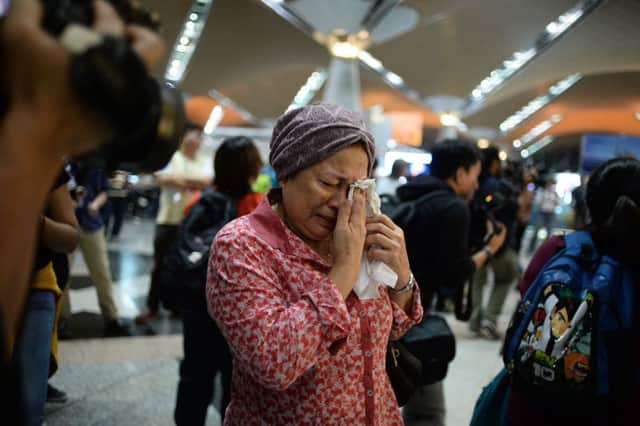Ukraine crash: Did Russians arm separatists?


At the height the aircraft was flying – some 33,000ft according to reports – it is thought unlikely it could have been hit by a missile from a shoulder-mounted launcher, which rebels in eastern Ukraine are known to have.
Anton Gerashenko, an aide to the Ukrainian interior minister, last night claimed the Amsterdam to Kuala Lumpur flight was hit by a missile fired from a Buk launcher, a Soviet-era surface-to-air missile system capable of taking down a high-altitude aircraft.
Advertisement
Hide AdAdvertisement
Hide AdBoth Ukraine and Russia have denied responsibility. It is now feared rebels could have acquired the weapons, probably from the Russians, since a large armoured vehicle mounted with rows of missiles was reported to have been seen in the area in recent days.
Armed groups like those in the Donetsk People’s Republic, which is battling Petro Poroshenko’s democratic government, have long been reported to have been supplied with arms by the Russians.
Experts said that it was implausible to suppose that the rebel groups could have perpetrated the attack without Russian support.
Jonathan Eyal, international director of the Royal International Services Institute in London, said: “Of course at this stage it is still theoretically feasible that it could have been the Ukrainian armed forces, the rebels or the Russians. But up to now there hasn’t been any instance of the Ukrainians having used their air defence system against aircraft for the simple reason that the rebels don’t have aircraft. The idea that this was mistakenly shot down by the Ukrainians is not plausible.
“It can’t be a rebel force on its own. They couldn’t have operated this system without Russian direct involvement. Even if the rebels were to have a missile system – which is possible, because it was transferred by the Russians – it is difficult to see how anyone could have operated it without a radar system which not merely guides the missile but targets the missile in the first place.”
Aviation experts warned the incident was an extremely serious new development in air travel.
Implications could include Ukrainian airspace being closed, meaning diversions for UK carriers who currently fly to and over the area.
Last night, German airline Lufthansa said it had decided to “fly a wide detour around east Ukrainian airspace with immediate effect”. Virgin Atlantic said it would re-route flights to avoid the area.
Advertisement
Hide AdAdvertisement
Hide AdDavid Kaminski-Morrow, air transport editor of Flightglobal magazine, said: “This could be a very serious development.
“If reports are true, we are not talking about small-arms fire but serious weaponry. Normally even if planes fly over a war zone they can go high enough for the conflict not to be a worry.
“Any decision about the opening or closing of Ukrainian airspace will be a matter for the Ukrainians. It could well be that part, or all, of that airspace will now be closed. Also, airlines, including UK carriers, could decide to detour around Ukraine.”
Mr Kaminski-Morrow added: “It’s really quite incredible that it should be Malaysia Airlines involved in this, after what happened earlier in the year.
“This is not a small airline on a faraway route. This was a major airline flying from a European destination to a capital in the Far East. There must be serious concerns about how the airline can recover from this. There will obviously be political as well as aviation concerns from all this. This will run and run.”
Norman Shanks, the former head of group security at airports group BAA, and professor of aviation security at Coventry University, said: “It is a busy aviation route and there have been suggestions that a notice was given to aviators telling airlines to avoid that particular area.
“But Malaysia Airlines, like a number of other carriers, have been continuing to use it because it is a shorter route, which means less fuel and therefore less money.
“I expect the area will be declared a no-fly zone and aircraft will have no choice but to take a different, longer route.”
Advertisement
Hide AdAdvertisement
Hide AdBuk radar can target planes but not identify if they are military or civilian
The Buk missile system is a family of self-propelled, medium-range, surface-to-air weapon developed by the former Soviet Union and Russian Federation and designed to target cruise missiles, smart bombs, aircraft and helicopters, and unmanned drones.
The system is operated by numerous countries, including Russia, Belarus, Syria, Cyprus, India, North Korea, Finland and Ukraine.
The manufacturer’s website, which also lists military equipment including radar and naval missile systems, displays two models of Buk launchers – the Buk-M1-2 and the Buk-M2E.
A description of the Buk-M1-2 states it has an altitude target range of up to 82,000ft, easily reaching the 40,000ft flight ceiling most airliners are certified for.
It says it is designed to “provide air defence for troops and facilities against attacks” from aircraft, attack helicopters and tactical ballistic, cruise, and air-to-air missiles, “in conditions of heavy radio jamming and counter fire; as well as to destroy water and ground surface targets”.
Meanwhile, the Buk-M2E “is designed to destroy tactical and strategic aircraft, helicopters, cruise missiles, at any point in their range of operation, along with tactical ballistic and aircraft missiles, and smart air bombs”.
It is believed that the battlefield radar system carried by Buk systems would not be sophisticated enough to differentiate between a military and civilian aircraft.
Advertisement
Hide AdAdvertisement
Hide AdIt is thought that Buk missile systems operated by Georgian forces were responsible for downing four Russian aircraft, including a strategic bomber, during the 2008 South Ossetia war.
And in January 2014 the Israeli Air Force launched an air strike on a convoy believed to be carrying Buk missiles from Syria to Hezbollah rebels in Lebanon, which the Syrian government denied.